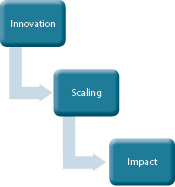This is the first post in a series about the Transformative Change Initiative, and is based on the 2014 TCI booklet. The series begins with defining transformative change and scaling, then details the seven guiding principles in the TCI Framework, and finally, provides snapshots of how TCI is supporting scaling and innovation through the TCI Network.
The Transformative Change Initiative (TCI) is dedicated to assisting community colleges to scale-up innovation in the form of guided pathways, programs of study, and evidence-based strategies to improve student outcomes and program, organization, and system performance.
Transformative change refers to implementing, sustaining, and scaling change that produces unprecedented results without sacrificing the historic commitment of community colleges to access, opportunity, and equitable outcomes.
Scaling Transformative Change
Strategic implementation of guided pathways, programs of study, and evidence-based strategies is a critical goal of TCI. How can this be done? Jeanne Century, a leading researcher on scaling innovation in Science, Technology, Engineering, and Mathematics (STEM) education, claims two critical dimensions of scaling are spread and
endurance.1
Envisioning how innovation will spread and how it will endure is key to successful scaling in any context, and especially important in the education context.
Spread refers to determining whether scaling will be done within an organization or with other organizations. In other words, it refers to how wide the innovation will reach. Is scaling focused on impacting the organization that originates the innovation, or is it intended to impact multiple organizations (e.g., other community colleges, K-12 education, universities, workforce agencies, employers, community-based organizations, and others)? Setting clear targets to guide the spread of an innovation is necessary to obtain intended results.
Endurance is about how long an innovation will last and what processes are needed to ensure its proposed longevity. A committment to change over time has to be deliberate and sustained. Realistic timelines help implement and institutionalize change. According to Century, most innovations acclimate to the local context over time. Adaptation and acclimation are required for long-term endurance.2
Those who are engaged in scaling innovation should keep track of a fundamental goal of scaling, which is to grow impact.3 Kathleen Enright, the President and CEO of Grantmakers for Effective Organizations, claims scaling isn’t just about changing or doing things better, it’s about changing and doing better things to produce greater impact. In the educational context, greater impact is about improving outcomes, increasing social impact, and contributing to the public good.
Debra Bragg, OCCRL director and endowed professor at Illinois, researches the transition to college by youth and adults, especially student populations that have not attended college historically.
Century, J., Rudnick, M., & Freeman, C. (2010). A framework for measuring fidelity of implementation: A foundation for shared language and accumulation of knowledge. American Journal of Evaluation, 31, 199-218.
Century, J. (2013, December). 10 considerations for measuring the spread and endurance of educational innovations. Keynote address presented at the Transformative Change Initiative Evaluation Collaborative. Chicago, IL.
Enright, K. (2013, June). Pathways to grow impact. Keynote address presented at the Transformative Change Initiative Scaling Forum. Chicago, IL.
